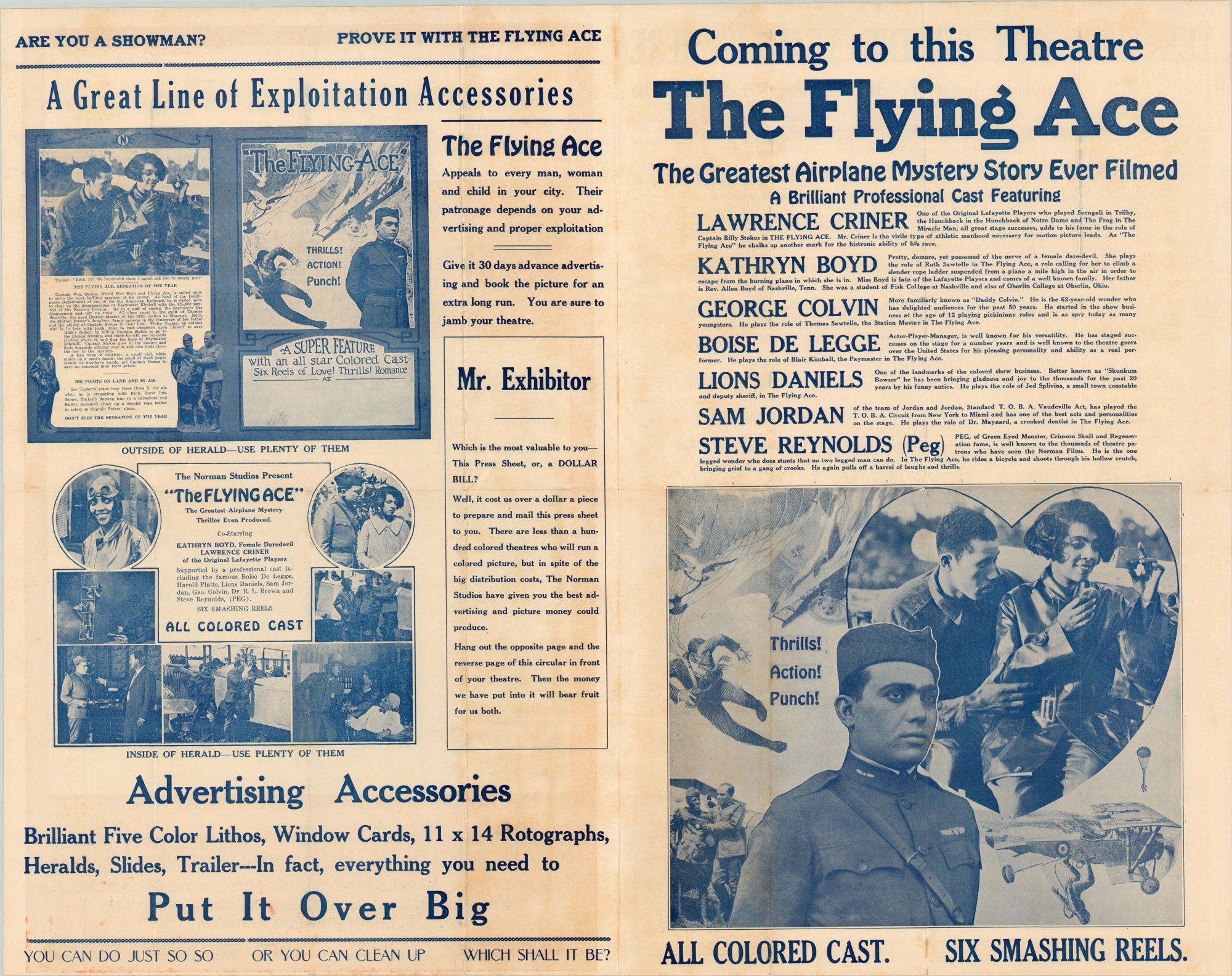The Flying Ace Movie Pressbook
$275.00
Thrills! Action! Punch! – promoting a popular 20th century race film.
1 in stock
Description
The Flying Ace was a 1926 silent, black & white drama film that featured an all African-American cast. It was produced by Norman Studios of Jacksonville, Florida as one of numerous ‘race films’ created and distributed to a primarily Black audience across America during the 1920s and 1930s.
This pressbook was distributed by the movie company to theaters across the nation in order to encourage them to show the film. Promotional text throughout the publication highlights the professional cast, broad appeal of the story and action-packed sequences.
“A Smashing Airplane Detective Mystery Done in a Smashing Way.” “The Flying Ace appeals to every man, woman and child in your city. Their patronage depends on your advertising and proper exploitation. Give it 30 days advance advertising and book the picture for an extra-long run. You are sure to jamb your theatre.”
The movie is one of the few race films to survive to this day, and was deemed culturally significant by the Library of Congress. It was shown at the 2010 San Francisco Film Festival, for which Megan Pugh wrote a fascinating article. An excerpt on Richard Norman is provided below;
Richard Norman, a white man who grew up in Middleburg, Florida, began his business career as an inventor of soft drinks but, after a couple years, abandoned tonics for the movies. By the mid-’teens, Norman was traversing the Midwest making “Home Talent Pictures,” which combined stock footage with scenes of locals who later turned out and paid to see themselves on screen. In 1916, Norman made The Green-eyed Monster, a feature-length love story set on the American rails, but it wasn’t until he remade it as The Love Bug in 1919 with an all-black cast that he found himself with a modest hit. In 1920, he returned home to Florida and devoted himself to making what were known as “race movies,” all-black films geared toward black audiences.
Before Norman arrived, Jacksonville had established itself as “The Winter Film Capital of the World.” Unlike New York, where the movie industry was initially based, Jacksonville got plenty of sun all year long. It boasted lush landscapes and various styles of buildings that could serve as ready-made backdrops, and, in the early to mid-’teens, the city was home to around 30 film companies, including Selig Polyscope, Essanay, and Edison. By the time WWI broke out, the industry had begun its move west. When Norman came home to set up shop, he met little competition for Jacksonville’s filmmaking resources. He bought what had once been Eagle Studios and, from 1920 to 1928, made seven feature-length race films that he produced, directed, and distributed virtually single-handedly.
Norman was committed to portraying the strength and nobility of black America, but he also recognized that race films were good business. During the Great Migration in the early 20th century, thousands of black Americans had moved from the South to the North and from country to the city, where they constituted a significant block of new consumers. Norman estimated that urban movie theaters reached a black audience of three million, while ten million more saw movies in segregated theaters, vaudeville, or at churches and schools. When these audiences looked to Hollywood to see themselves, they were disappointed. Black characters, if present at all, tended toward the stereotypes that film historian Donald Bogle summed up in the title of his 1973 book Toms, Coons, Mulattoes, Mammies, and Bucks. Race movies like Norman’s offered something new: a world where blacks overcome prejudice or, in films like The Flying Ace, never even encounter it.
Norman Films was part of what the film scholar Thomas Cripps has called the “black underground” of more than 100 companies making race movies in the ’teens and ’20s well outside of Hollywood. (About half these companies were, like Norman Films, run by whites). But Norman’s skill as a filmmaker and a businessman soon catapulted him to the top of the heap. Norman Films became one of the three leading producers of race films in America, along with the Lincoln Motion Picture Company and the Micheaux Film Corporation.”
Map Details
Publication Date: 1926
Author: Norman Studios
Sheet Width (in): 14
Sheet Height (in): 22
Condition: B+
Condition Description: Double page pressbook issued on news sheet and folded into 8 segments. Creasing and light wear along fold lines and minor discoloration on the back page, but overall in good to very good condition.
$275.00
1 in stock


